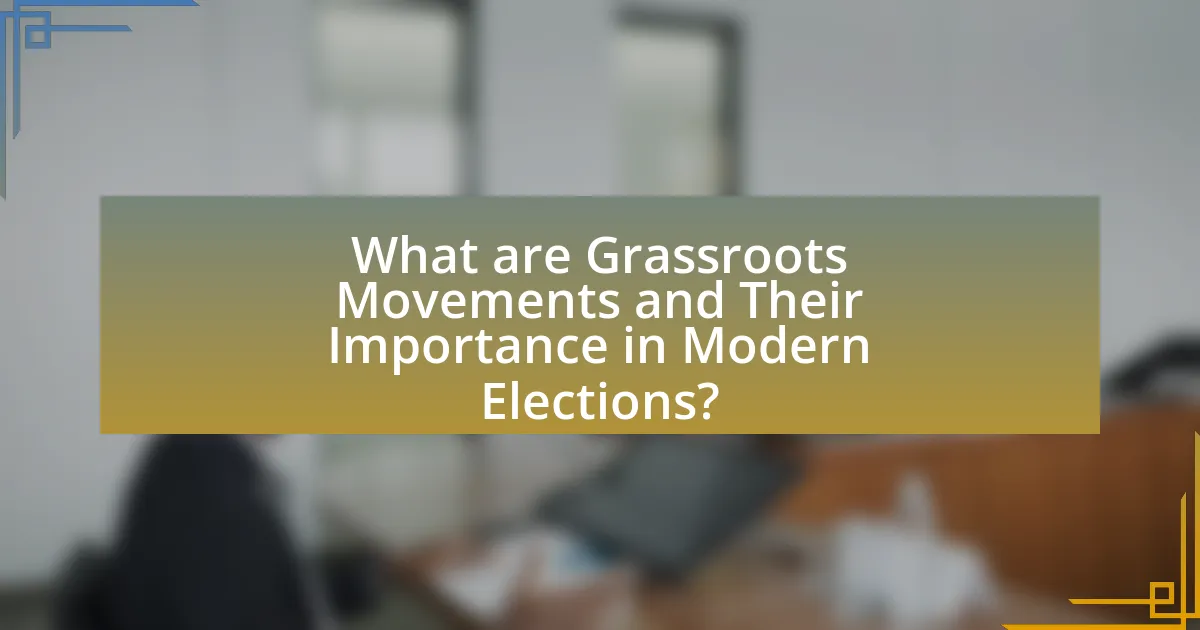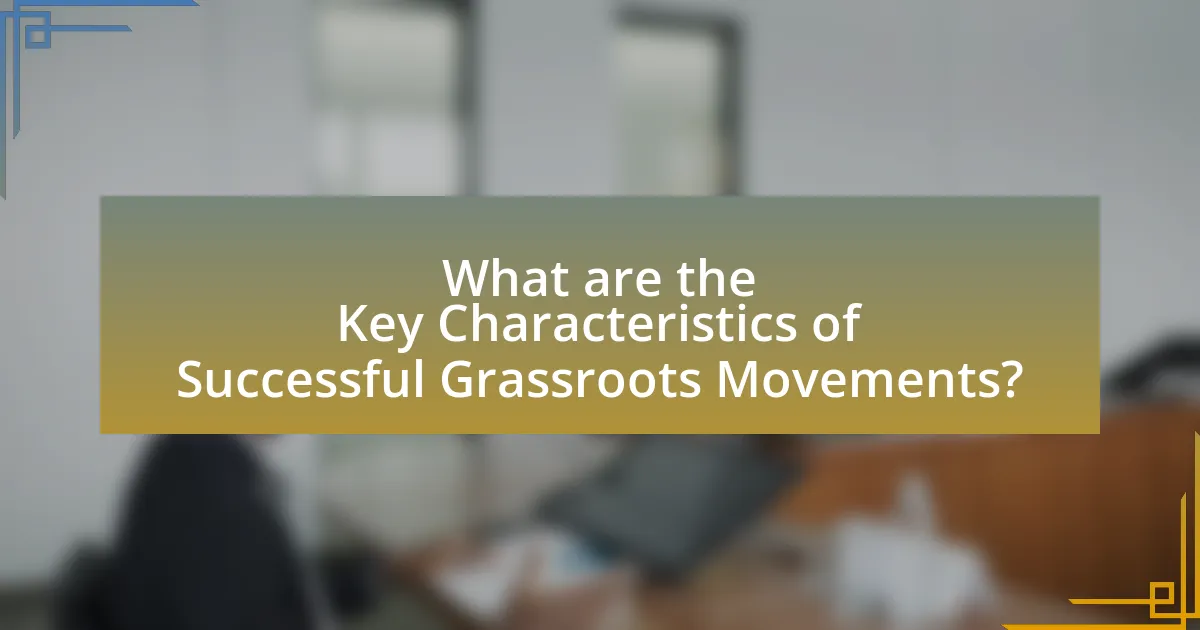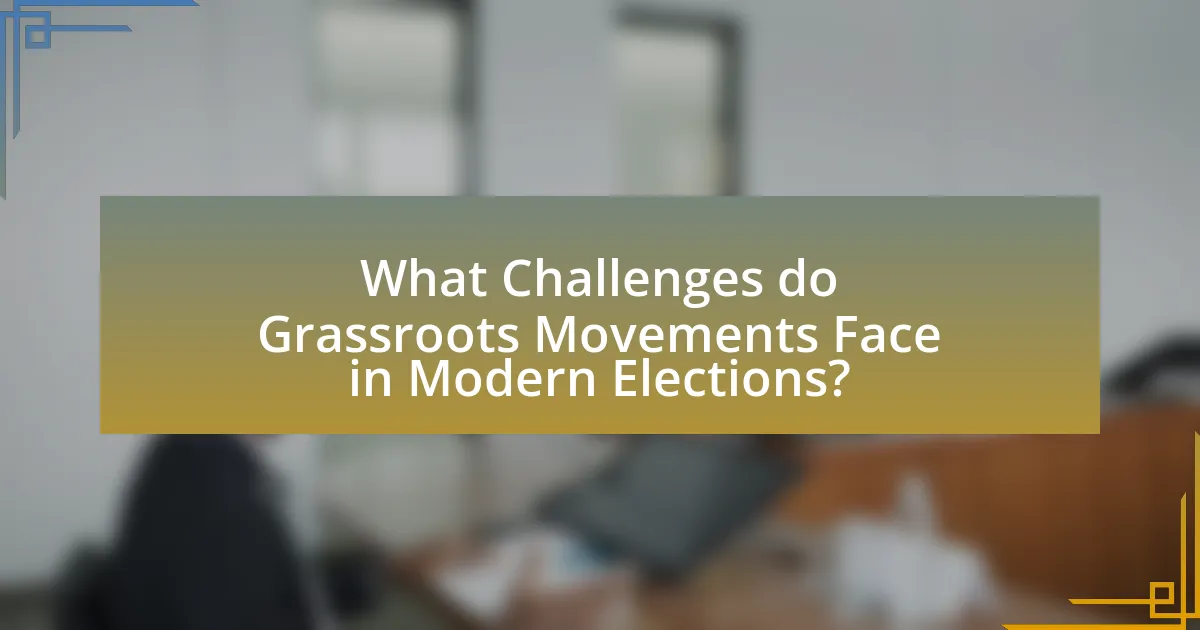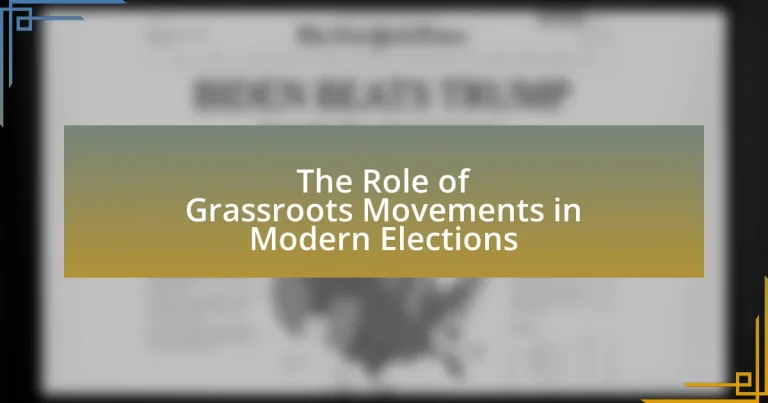Grassroots movements are organized efforts by ordinary citizens aimed at achieving social or political change, often emerging from local communities. This article explores the significance of grassroots movements in modern elections, highlighting their ability to mobilize voters, influence public opinion, and shape policy outcomes. Key topics include the strategies employed by these movements to engage communities, the challenges they face, and the impact of social media on their effectiveness. Additionally, the article examines successful case studies and best practices that illustrate how grassroots initiatives can enhance voter turnout and drive political change.

What are Grassroots Movements and Their Importance in Modern Elections?
Grassroots movements are organized efforts by ordinary people to effect social or political change, often emerging from local communities rather than established political institutions. Their importance in modern elections lies in their ability to mobilize large numbers of individuals, raise awareness about specific issues, and influence public opinion and policy. For instance, the 2018 midterm elections in the United States saw a significant increase in grassroots campaigning, which contributed to higher voter turnout and the election of diverse candidates. Research by the Pew Research Center indicates that grassroots efforts can lead to increased civic engagement, demonstrating their critical role in shaping electoral outcomes and fostering democratic participation.
How do Grassroots Movements influence voter engagement?
Grassroots movements significantly influence voter engagement by mobilizing communities and fostering a sense of collective action. These movements often utilize local networks to educate citizens about issues, encouraging participation in the electoral process. For instance, the 2018 midterm elections in the United States saw a surge in voter turnout, attributed in part to grassroots organizations like Indivisible and MoveOn, which engaged millions through door-to-door canvassing and social media campaigns. Research indicates that grassroots efforts can increase voter turnout by as much as 10% in targeted demographics, demonstrating their effectiveness in energizing the electorate.
What strategies do Grassroots Movements use to mobilize voters?
Grassroots movements mobilize voters through community engagement, targeted outreach, and leveraging social media. These strategies involve organizing local events, door-to-door canvassing, and phone banking to directly connect with potential voters. For instance, the 2018 midterm elections saw grassroots organizations like Indivisible successfully mobilize millions of voters by focusing on local issues and fostering community discussions. Additionally, social media platforms enable grassroots movements to disseminate information rapidly, engage younger demographics, and create viral campaigns that raise awareness and encourage voter participation.
How do Grassroots Movements impact voter turnout?
Grassroots movements significantly increase voter turnout by mobilizing communities and fostering engagement through localized efforts. These movements often utilize door-to-door canvassing, social media campaigns, and community events to raise awareness about the importance of voting and to provide information on how to participate in elections. For instance, a study by the National Bureau of Economic Research found that grassroots mobilization efforts can increase voter turnout by as much as 10% in targeted demographics. This demonstrates that grassroots movements effectively energize and inform potential voters, leading to higher participation rates in elections.
Why are Grassroots Movements essential for political change?
Grassroots movements are essential for political change because they mobilize ordinary citizens to advocate for social and political issues, thereby influencing policy and decision-making. These movements often arise from community needs and concerns, allowing individuals to collectively voice their demands, which can lead to significant shifts in public policy. For instance, the Civil Rights Movement in the United States, driven by grassroots activism, resulted in landmark legislation such as the Civil Rights Act of 1964 and the Voting Rights Act of 1965, demonstrating the power of organized citizen action in effecting political change.
What role do Grassroots Movements play in shaping public policy?
Grassroots movements play a crucial role in shaping public policy by mobilizing community members to advocate for specific issues, influencing lawmakers and public opinion. These movements often arise from local concerns and can lead to significant policy changes, as seen in the civil rights movement, which resulted in landmark legislation like the Civil Rights Act of 1964. Additionally, grassroots campaigns can leverage social media to amplify their messages, engage a broader audience, and pressure decision-makers, exemplified by the climate justice movement’s impact on environmental policies.
How do Grassroots Movements challenge established political structures?
Grassroots movements challenge established political structures by mobilizing community members to advocate for change outside traditional political channels. These movements often leverage social media and local organizing to raise awareness about issues, thereby influencing public opinion and pressuring political leaders to respond. For instance, the Black Lives Matter movement has significantly impacted discussions on police reform and racial justice, demonstrating how grassroots activism can reshape policy agendas and force established political entities to address systemic inequalities. This influence is evident in the increased attention to social justice issues in political platforms and legislative proposals following grassroots advocacy.

What are the Key Characteristics of Successful Grassroots Movements?
Successful grassroots movements are characterized by strong community engagement, clear goals, and effective communication strategies. These movements mobilize individuals at the local level, fostering a sense of ownership and participation among community members. For instance, the Civil Rights Movement in the United States exemplified this by involving local activists who organized protests and voter registration drives, leading to significant legislative changes. Additionally, successful grassroots movements often utilize social media to amplify their message and connect with a broader audience, as seen in the Arab Spring, where online platforms played a crucial role in mobilizing support and coordinating actions.
What factors contribute to the effectiveness of Grassroots Movements?
The effectiveness of grassroots movements is primarily influenced by community engagement, clear messaging, and strategic use of social media. Community engagement fosters a sense of ownership and mobilizes local support, as seen in the success of movements like Black Lives Matter, which gained traction through local activism and participation. Clear messaging ensures that the movement’s goals resonate with a broad audience, exemplified by the Women’s March, which unified diverse groups around common issues. Additionally, strategic use of social media amplifies outreach and facilitates rapid organization, evidenced by the viral spread of campaigns like #MeToo, which highlighted social injustices and mobilized global support. These factors collectively enhance the ability of grassroots movements to effect change and influence modern elections.
How does community involvement enhance the success of Grassroots Movements?
Community involvement significantly enhances the success of grassroots movements by fostering local engagement and building a strong support network. When community members actively participate, they contribute diverse perspectives and resources, which can lead to more effective strategies and solutions tailored to local needs. For instance, a study by the Stanford Social Innovation Review found that grassroots movements with high community engagement are more likely to achieve their goals, as they mobilize a larger base of volunteers and financial support. This collective action not only amplifies the movement’s voice but also increases its visibility and credibility, making it more likely to influence policy and public opinion.
What role does social media play in the success of Grassroots Movements?
Social media is crucial for the success of grassroots movements as it facilitates rapid communication, mobilization, and engagement among supporters. By providing platforms for sharing information, grassroots movements can quickly disseminate their messages, organize events, and rally support, often reaching a wider audience than traditional media allows. For instance, the Black Lives Matter movement effectively utilized Twitter and Facebook to raise awareness and mobilize protests, demonstrating that social media can amplify voices and foster community action. Additionally, studies show that social media engagement can significantly increase participation rates in grassroots campaigns, as seen in the 2018 midterm elections in the United States, where online organizing contributed to higher voter turnout among younger demographics.
How do Grassroots Movements build coalitions and alliances?
Grassroots movements build coalitions and alliances by fostering relationships among diverse groups that share common goals. They achieve this through inclusive dialogue, shared resources, and collaborative strategies that emphasize mutual benefits. For instance, the Women’s March in 2017 successfully united various organizations, including labor unions and civil rights groups, by focusing on shared values such as equality and justice. This coalition-building approach enhances their collective power and visibility, allowing them to mobilize larger audiences and influence policy effectively.
What are the benefits of collaboration among Grassroots Movements?
Collaboration among grassroots movements enhances their effectiveness by pooling resources, amplifying voices, and increasing visibility. When grassroots movements unite, they can share knowledge, strategies, and networks, which leads to more impactful campaigns. For instance, the collaboration seen in the 2017 Women’s March, where various organizations came together, resulted in a significant turnout and heightened awareness of women’s rights issues. This collective action not only strengthened their individual causes but also created a broader platform for advocacy, demonstrating that unified efforts can lead to greater political influence and social change.
How can Grassroots Movements effectively communicate their goals to a wider audience?
Grassroots movements can effectively communicate their goals to a wider audience by utilizing social media platforms, community engagement, and clear messaging. Social media allows these movements to reach large audiences quickly; for instance, platforms like Twitter and Facebook have been instrumental in mobilizing support for various causes, as evidenced by the rapid spread of the #MeToo movement, which gained global attention and support through online sharing. Community engagement, such as organizing local events and town hall meetings, fosters direct interaction with constituents, allowing movements to articulate their goals and gather feedback. Clear messaging, characterized by concise and relatable language, ensures that the core objectives resonate with diverse audiences, as seen in the successful campaigns of organizations like Black Lives Matter, which effectively communicated their mission through straightforward slogans and impactful visuals.

What Challenges do Grassroots Movements Face in Modern Elections?
Grassroots movements face significant challenges in modern elections, primarily due to limited funding, media visibility, and organizational capacity. Limited financial resources hinder their ability to compete against well-funded political campaigns, making it difficult to reach a broad audience. Additionally, mainstream media often prioritizes established candidates, resulting in reduced coverage for grassroots initiatives, which diminishes their public exposure. Furthermore, grassroots movements frequently struggle with organizational challenges, such as mobilizing volunteers and maintaining consistent messaging, which can weaken their overall impact. These factors collectively impede the effectiveness of grassroots movements in influencing electoral outcomes.
What obstacles hinder the progress of Grassroots Movements?
Grassroots movements face several obstacles that hinder their progress, including limited funding, lack of media coverage, and internal divisions. Limited funding restricts their ability to mobilize resources effectively, as many grassroots initiatives rely on small donations and volunteer efforts. Lack of media coverage diminishes their visibility and public awareness, making it challenging to gain traction and support. Internal divisions can lead to conflicts over goals and strategies, which can weaken the movement’s overall effectiveness. These factors collectively impede the ability of grassroots movements to influence modern elections and achieve their objectives.
How do funding and resource limitations affect Grassroots Movements?
Funding and resource limitations significantly hinder grassroots movements by restricting their ability to mobilize, organize, and sustain campaigns. Without adequate financial support, these movements struggle to reach wider audiences, limiting their outreach efforts and reducing their visibility in the political landscape. For instance, a study by the National Democratic Institute found that grassroots organizations with limited funding often fail to compete effectively against well-funded opponents, resulting in diminished influence on policy and electoral outcomes. Additionally, resource constraints can lead to reliance on volunteer labor, which may not be sustainable over time, further weakening the movement’s capacity to effect change.
What strategies can Grassroots Movements employ to overcome these challenges?
Grassroots movements can employ strategies such as community organizing, coalition building, and leveraging social media to overcome challenges. Community organizing allows grassroots movements to mobilize local support and create a strong base of volunteers, which is essential for effective campaigning. Coalition building enables these movements to unite with other organizations, amplifying their voice and resources, as seen in the success of movements like the Women’s March, which brought together diverse groups to advocate for women’s rights. Additionally, leveraging social media platforms facilitates rapid communication and outreach, allowing grassroots movements to engage with a broader audience and disseminate their message effectively, as evidenced by the viral campaigns during the 2016 U.S. presidential election. These strategies collectively enhance the capacity of grassroots movements to navigate obstacles and influence electoral outcomes.
How do Grassroots Movements navigate political opposition?
Grassroots movements navigate political opposition by employing strategic coalition-building, grassroots mobilization, and effective communication. These movements often form alliances with like-minded organizations to amplify their voice and increase their influence, as seen in the Women’s March in 2017, which united various groups advocating for women’s rights and social justice. Additionally, grassroots movements utilize social media platforms to mobilize supporters quickly and disseminate their messages widely, allowing them to counteract political opposition effectively. For instance, the Black Lives Matter movement has successfully leveraged social media to organize protests and raise awareness about systemic racism, despite facing significant political pushback. This combination of coalition-building, mobilization, and communication enables grassroots movements to persist and adapt in the face of political challenges.
What tactics are effective in countering negative narratives against Grassroots Movements?
Effective tactics for countering negative narratives against grassroots movements include strategic communication, coalition-building, and leveraging social media. Strategic communication involves crafting clear, positive messages that highlight the movement’s goals and successes, which can counter misinformation. Coalition-building with other organizations enhances credibility and amplifies the movement’s voice, as seen in the collaboration between various civil rights groups during the 1960s, which strengthened their collective impact. Leveraging social media allows grassroots movements to directly engage with supporters and disseminate accurate information rapidly, as demonstrated by the use of platforms like Twitter and Facebook during recent political campaigns, which helped to mobilize and inform voters effectively.
How can Grassroots Movements maintain momentum in the face of adversity?
Grassroots movements can maintain momentum in the face of adversity by fostering strong community engagement and utilizing digital platforms for communication and organization. Engaging local communities creates a sense of ownership and commitment, which is crucial for sustaining efforts during challenging times. For instance, the Black Lives Matter movement effectively mobilized support through community events and local chapters, demonstrating that grassroots involvement can amplify voices and maintain focus on objectives despite opposition. Additionally, leveraging social media allows for rapid dissemination of information and coordination of actions, as seen in various movements that have successfully organized protests and campaigns online. This combination of community involvement and digital strategy provides resilience against setbacks, ensuring that grassroots movements can continue to push for their goals even when faced with significant challenges.
What are the Best Practices for Grassroots Movements in Modern Elections?
The best practices for grassroots movements in modern elections include building a strong community network, leveraging social media for outreach, and focusing on local issues that resonate with constituents. Strong community networks foster trust and mobilize volunteers effectively, as seen in the 2018 midterm elections where grassroots organizations significantly increased voter turnout by engaging local communities. Utilizing social media platforms allows movements to reach a wider audience quickly and cost-effectively; for instance, the Bernie Sanders campaign in 2016 effectively used social media to engage younger voters. Additionally, addressing local issues ensures that the movement remains relevant and relatable, as evidenced by the success of movements that prioritize specific community needs, leading to increased support and participation.
How can Grassroots Movements effectively engage with their communities?
Grassroots movements can effectively engage with their communities by fostering direct communication and building trust through local involvement. These movements often utilize community meetings, social media platforms, and local events to create dialogue and gather input from residents. For instance, the 2018 midterm elections in the United States saw grassroots organizations mobilizing voters by hosting town halls and door-to-door canvassing, which significantly increased voter turnout in local elections. Research indicates that personal interactions and localized strategies enhance community participation, as evidenced by the increase in voter engagement in areas where grassroots efforts were concentrated.
What lessons can be learned from successful Grassroots Movements in recent elections?
Successful grassroots movements in recent elections demonstrate the importance of community engagement, effective communication, and mobilization strategies. These movements often leverage social media platforms to build networks and spread their messages rapidly, as seen in the 2018 midterm elections in the United States, where organizations like Indivisible mobilized millions of voters. Additionally, successful grassroots efforts emphasize the significance of local issues and personal narratives, which resonate more deeply with constituents, leading to increased voter turnout. For instance, the Sunrise Movement effectively highlighted climate change as a critical issue, influencing the Democratic Party’s platform. These examples illustrate that grassroots movements can significantly impact electoral outcomes by fostering a sense of community and urgency around specific issues.


